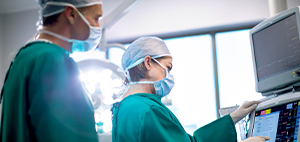Male breast cancer accounts for less than one percent of all breast cancer diagnoses. About one in 833 men will develop breast cancer in their lifetime. In comparison, one in eight women will be diagnosed with breast cancer in their lifetime.
More than 2,700 men are diagnosed with breast cancer each year and approximately 530 men die from the disease, according to the American Cancer Society. In comparison, about 310,720 women will be diagnosed in 2024 and 42,250 will die, according to the same statistics. Male breast cancer is most common in older men, though it can occur at any age.
Signs and symptoms of male breast cancer
Among the things you might notice are:
- A painless lump or thickening in your breast tissue
- Changes to the skin covering your breast, such as dimpling, puckering, redness or scaling
- Changes to your nipple, such as redness or scaling, or a nipple that begins to turn inward
- Discharge from your nipple
When to see a medical provider
Make an appointment with your provider if you have any persistent signs or symptoms stated above or have other changes that worry you.
Causes of breast cancer in men
- Some men inherit abnormal (mutated) genes from their parents that increase the risk of breast cancer. Mutations in one of several genes, especially a gene called BRCA2, put you at greater risk of developing breast and prostate cancers
- Most breast cancers in men are not caused by inherited factors. Nevertheless, knowing a man’s family history can be informative and help guide decisions regarding the need for genetic testing. Exposure to radiation treatment to the chest, as well as conditions that increase levels of estrogen—such as obesity—are also factors that influence the risk of breast cancer in men. Read more about risk factors below.
The risk of breast cancer increases as you age. Male breast cancer is most often diagnosed in men in their 60s (median age is 63).
If you take estrogen-related drugs, such as those used for hormone therapy for prostate cancer, your risk of breast cancer is increased.
If you have a close family member with breast cancer, you have a greater chance of developing the disease.
This genetic syndrome occurs when boys are born with more than one copy of the X chromosome. Klinefelter’s syndrome causes abnormal development of the testicles. As a result, men with this syndrome produce lower levels of certain male hormones (androgens) and more female hormones (estrogens).
Certain conditions, such as cirrhosis of the liver, can reduce male hormones and increase female hormones, increasing your risk of breast cancer.
Obesity is associated with higher levels of estrogen in the body, which increases the risk of male breast cancer.
Having inflamed testicles (orchitis) or surgery to remove a testicle (orchiectomy) can increase your risk of male breast cancer.
Diagnosing male breast cancer
Your doctor may conduct a number of diagnostic tests and procedures, such as:
Your provider uses his or her fingertips to examine your breasts and surrounding areas for lumps or other changes. Your provider assesses how large the lumps are, how they feel, and how close they are to your skin and muscles.
Imaging tests create pictures of your breast tissue that allow our breast radiologists to identify abnormal areas. For men aged 25 and older, initial imaging includes digital mammography/tomosynthesis.
A mammogram (X-ray) of both breasts is typically performed in symptomatic men. Mammography is highly sensitive and specific in distinguishing benign from malignant disease. In conjunction with mammography, ultrasound is often useful in assisting with management decisions and to facilitate ultrasound-guided core biopsy when needed.
A core-needle biopsy is the only definitive way to make a diagnosis of breast cancer. During a biopsy, the breast radiologist uses a specialized needle device guided by ultrasound or X-ray to sample a core of tissue from the suspicious area.
Biopsy samples are sent to a laboratory for analysis where our expert pathologist determines whether the cells are cancerous. A biopsy sample is also analyzed to determine the type of cells involved with the instance of breast cancer, the aggressiveness (grade) of the cancer, and whether the cancer cells have hormone receptors or other receptors that may influence your treatment options. Other tests and procedures may be recommended depending on your particular situation.
Can breast cancer in men be prevented?
Since the cause of most breast cancers is not known, there is no known way to prevent them. But there are some things a man can do to lower his risk of breast cancer:
Both increased body weight and weight gain as an adult are linked with a higher risk of breast cancer. And since being overweight or obese is linked with an increased risk for several cancers, the American Cancer Society recommends you stay at a healthy weight throughout your life and avoid excess weight gain by balancing your food intake with physical activity.
Alcohol use increases the risk of breast cancer in women. Even low levels of alcohol intake have been linked with an increase in risk. Alcohol use is linked with several cancers and is the third most important preventable risk factor for cancer. It is best not to drink alcohol. For men who do drink, they should have no more than 2 alcoholic drinks a day.
Many studies have shown that moderate to vigorous physical activity is linked with lower breast cancer risk in women, as well as many other types of cancer. The American Cancer Society recommends that adults get at least 150 to 300 minutes of moderate-intensity activity or 75 to 150 minutes of vigorous-intensity activity each week (or a combination of these), preferably spread throughout the week. Getting to or going over the upper limit of 300 minutes is ideal.
For now, the best strategies for reducing the number of deaths caused by this disease are early detection and prompt treatment. Early detection has been a problem for men, who may not notice breast lumps, or see their doctor only when the lumps have gotten large. In general, men are diagnosed with breast cancers at more advanced stages than are women. Remember, annual screening mammography is recommended in women beginning at age 40, contributing to women’s cancers being found earlier.
To read more about other ways to reduce your cancer risk in general, such as keeping physically active and following a healthy eating pattern, see the American Cancer Society guideline for diet and physical activity for cancer prevention.
Treatment
Men diagnosed with male breast cancer at an early stage have a good chance for a cure. Treatment typically involves surgery to remove the breast tissue. Other treatments, such as chemotherapy and radiation therapy, may be recommended based on your particular situation.




